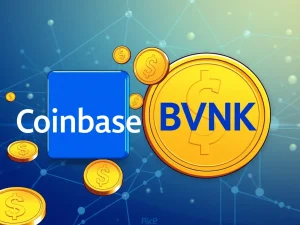Shocking Fate: What Happens to a Dead Blockchain?

Imagine a bustling city suddenly deserted. Buildings stand tall, roads are paved, but silence reigns. This eerie stillness mirrors the fate of a blockchain when it falls into disuse. In the vibrant world of cryptocurrency, not every blockchain becomes a thriving hub. Some, despite their initial promise, end up as digital ghost towns – blockchains where transactions cease, developers vanish, and holders are left with tokens of dwindling value. What causes this **blockchain inactivity**, and is there any hope for **blockchain revival**? Let’s delve into the intriguing world of dormant chains and **active blockchains**.
Why Blockchains Become Digital Graveyards
Several factors can lead to a blockchain’s demise, turning it into a **dead blockchain**. It’s not always about flawed technology; sometimes, even innovative projects can wither without the right ingredients for survival. Here are key reasons why some blockchains fade away:
- Tokenomics Failures: Poorly designed token economies can kill a project. If incentives are misaligned or unsustainable, users and developers lose interest.
- Scams and Security Breaches: Projects exposed as scams or those suffering from significant security breaches erode trust, often beyond repair.
- Lack of Community and Development Momentum: A vibrant community and continuous development are the lifeblood of any blockchain. Without them, even the most cutting-edge tech stagnates.
Think of blockchains like ecosystems. They need active participation to thrive. Without users, developers, and validators, a blockchain network can become as functional as a broken clock – technically there, but practically useless.
**Blockchain Adoption** Challenges in 2025
Even in 2025, **blockchain adoption** faces significant hurdles. Despite the progress made by pioneers like Ethereum and Solana, widespread acceptance isn’t guaranteed. Several challenges persist:
- Regulatory Uncertainty: The evolving regulatory landscape casts a long shadow. Inconsistent or restrictive regulations can stifle innovation before it has a chance to flourish. Governments worldwide are still grappling with how to regulate crypto assets, creating uncertainty that deters wider **blockchain adoption**.
- Fragmented Developer Ecosystem: The blockchain space is a patchwork of technologies. Developers must navigate a complex landscape of languages like Solidity, Rust, and Move. Attracting and retaining talent across these diverse platforms is a constant challenge.
- The User Problem: Bots vs. Real Engagement: Many blockchains struggle with authentic user engagement. Metrics can be misleadingly inflated by bots chasing airdrops, rather than genuine users interacting with the technology. True **blockchain adoption** requires real people finding real utility.
- Infrastructure Gaps: Robust infrastructure is crucial. Blockchains need reliable tooling, high-quality RPC services, and decentralized validator sets to ensure uptime and security. These infrastructural elements are the backbone supporting **blockchain adoption** and usage.
- Community and Trust Deficit: A thriving blockchain needs a strong, passionate community. This community, comprised of users, builders, and commentators, must believe in the project’s long-term vision. Overcoming fear, uncertainty, and doubt (FUD) is critical for maintaining trust and fostering genuine **blockchain adoption**.
In the context of blockchains, RPC (Remote Procedure Call) services are essential for applications to interact with the network. They act as communication channels, enabling wallets, DApps, and developer tools to fetch data or broadcast transactions. Without reliable RPC infrastructure, **blockchain adoption** and usability suffer.
What Blockchains Are Still **Active Blockchains** in 2025?
As of April 2025, several blockchains stand out as **active blockchains**, each carving a niche in the crypto landscape. These chains demonstrate consistent user engagement, developer activity, and substantial transaction volume, contrasting sharply with inactive networks that have become digital graveyards. Here’s a snapshot of some leading **active blockchains**:
| Blockchain | Focus | Key Metrics (April 2025) |
|---|---|---|
| Bitcoin | Value Storage | $1.636T Market Cap (April 6, 2025), 960+ Developers (Scalability) |
| Ethereum | DeFi, NFTs, DApps | Millions of Daily Transactions (Layer 2s), 5,900+ Monthly Active Developers (June 2023), High TVL |
| Solana | Speed, Low Fees, DeFi, Gaming | 3.68M Daily Active Addresses (April 8, 2025), 1,400+ Developers (June 2023) |
| BNB Chain | Affordable Transactions, DeFi, Gaming | 1.93M Daily Users (April 1, 2025), Notable TVL and Volume |
| Polkadot | Interoperability | 1,900+ Developers (June 2023), Growing Parachain Activity |
| Near Protocol | Scalability (Sharding), DeFi, Gaming | 3.18M Daily Addresses (April 1, 2025), Developer Tools Growth |
| Sui | Speed, DeFi, Gaming | 2.46M Daily Users (April 1, 2025), Object-Oriented Model |
| Tron | Stablecoin Transfers | 2.45M Daily Addresses (April 1, 2025), High Throughput |
These **active blockchains** are characterized by daily user engagement, consistent developer momentum, and sustained transaction volume. In contrast, inactive chains like EOS and Terra serve as cautionary tales, highlighting the consequences of governance failures or catastrophic collapses.
The health of a blockchain boils down to daily activity. Are people actually using it? Are developers actively building? Is there meaningful transaction volume? If the answer is a resounding “no,” the chain might be on a path to becoming a digital relic.
Blockchains That Faded: What Went Wrong?
The stories of blockchains like EOS and Terra offer valuable lessons. Initial hype is insufficient for long-term survival. Sustaining a blockchain requires real utility, unwavering trust, and continuous innovation. These examples demonstrate that:
- Hype is Fleeting: Early excitement doesn’t guarantee longevity.
- Utility is Paramount: Blockchains need practical use cases that solve real-world problems.
- Trust is Essential: Users must trust the security and governance of the network.
- Evolution is Key: Continuous development and adaptation are necessary to remain relevant.
EOS, once hailed as an “Ethereum killer” after raising $4 billion in its ICO, exemplifies the dangers of unmet potential. By 2025, it experienced minimal usage due to governance challenges and low **blockchain adoption**. Terra, on the other hand, suffered a dramatic collapse when its algorithmic stablecoin imploded, wiping out billions in value. These cases underscore that hype alone is not a sustainable foundation. Real-world utility and robust security are crucial for enduring success.
How to Spot a Living Blockchain
To distinguish between a thriving blockchain and a **dead blockchain**, look for key metrics that signal health and vitality. These indicators can help you assess whether a blockchain is truly alive and trustworthy:
- Transaction Velocity and Volume: A healthy blockchain exhibits consistent transaction activity. Low activity is a critical warning sign of **blockchain inactivity**.
- Total Value Locked (TVL): TVL reflects the amount of assets users have deposited in DeFi protocols on a chain. A declining TVL suggests a loss of user confidence and capital flight.
- Developer Activity: A vibrant developer ecosystem is essential for ongoing innovation. The launch of new projects and continuous development are positive indicators. Stagnant developer activity often foreshadows decline.
- Validator and Node Count: A high number of validators enhances decentralization and network security. A robust validator set is a sign of a healthy, secure blockchain.
- Liquidity and Onchain Economy: The health of the onchain economy and liquidity levels are crucial. Drying liquidity can signal a chain’s dwindling prospects.
Project migrations can also indicate a blockchain’s health. For instance, the gaming project Infecteddotfun’s recent move from Base to Solana highlights the importance of scalability and user-centricity. Overwhelmed by user demand, Infecteddotfun shifted to Solana, citing Base’s scaling limitations and Solana’s robust infrastructure and community.
What Brings a **Blockchain Revival**?
Can a **dead blockchain** be resurrected? The answer is sometimes yes. **Blockchain revival** is possible, but it requires significant effort and strategic shifts. Here are factors that can contribute to bringing an inactive chain back to life:
- Compelling New Use Cases: Discovering a practical application that resonates with users can reignite interest. Solving a real-world problem can be the catalyst for **blockchain revival**.
- Protocol Upgrades and Improvements: Enhancements that improve scalability, reduce fees, or enhance interoperability can attract users and developers back to a network. Technical upgrades are often vital for **blockchain revival**.
- Strategic Incentives: Grants, airdrops, and liquidity rewards can incentivize developers and users to re-engage with a network. Targeted incentives can jumpstart **blockchain revival**.
- Evolution into Layer-2 Solutions: Struggling projects can pivot to become layer-2 solutions on more **active blockchains**, finding new relevance and utility within established ecosystems.
- Strong Community Conviction: A dedicated community with unwavering belief in the chain’s future can be the most powerful force for **blockchain revival**. Solana’s remarkable recovery after the FTX collapse, fueled by its committed community, serves as a compelling example.
The blockchain world is dynamic and unforgiving. While some networks flourish, others fade into obscurity. The blockchains that endure are those built on strong community support, real-world utility, and continuous innovation. If a blockchain seems silent today, its story might not be over, but **blockchain revival** demands more than just hope – it requires strategic action and a compelling reason for users to return.







